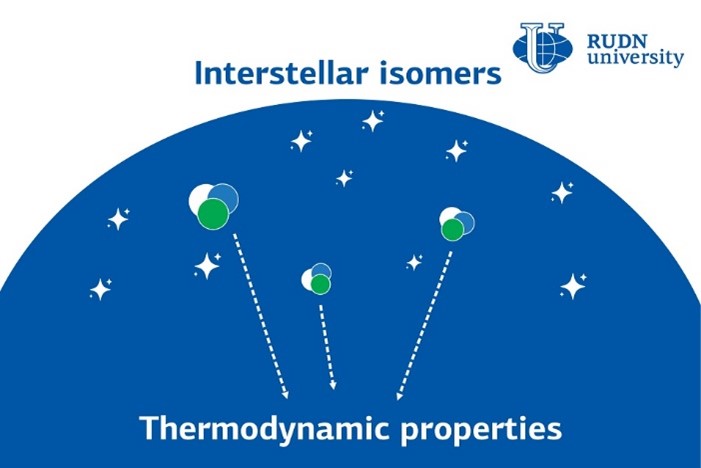RUDN physicists described the thermodynamics of interstellar molecules

Astrochemistry is a relatively new field science. According to the characteristics of the absorption and emission of light, scientists have learned to determine the composition of substances in interstellar space — that is, outside the solar system. Some of them are unique, some are isomers of each other, that is, they have the same composition, but a different structure. Based on this information, scientists not only draw conclusions about the structure of other star systems, but also understand more about life on Earth. The RUDN physicist described the thermodynamic properties of 10 species of five isomeric groups from interstellar space.
“The origin of life on Earth remains a controversial issue in various fields. For example, in terms of chemistry, we lack understanding of how simple molecules could evolve into complex molecular systems. Various compounds found in the interstellar medium serve as tools for solving the problem of the chemical origin of life. Our goal was to study the thermodynamic properties of some of these compounds,” Oladimeji Enok, researcher at the Institute of Physical Research and Technology, RUDN University.
Physicists have calculated the basic thermodynamic properties of 10 species: entropy, internal energy, free energy, heat capacity. All these are the so-called thermodynamic potentials — a complete set of natural and mutually independent variables that completely describe the state of a thermodynamic system.
RUDN physicists considered triatomic compounds from five isomeric groups. Moreover, four out of ten compounds have not yet been discovered in interstellar space, but their isomers have been discovered. The data obtained by physicists can be used to model various astrophysical environments. Including, the interstellar medium, protoplanetary disks, star formation regions.
“We studied the thermodynamic properties of 10 species from 5 isomeric groups with 3 atoms. We have provided a complete set of data for molecules of astrophysical significance. They can be used in simulations in various astrophysical environments. The thermodynamic parameters obtained in our study will find application in modeling a wide range of astrophysical environments, such as the interstellar medium, protoplanetary disks, star formation regions, and so on,” said Oladimeji Enock, researcher at the Institute of Physical Research and Technology, RUDN University.
The results are published in Advances in Space Research.
RUDN summarized the results of the scientific competition "Project Start: work of the science club ". Students of the Faculty of Physics, Mathematics and Natural Sciences have created a project for a managed queuing system using a neural network to redistribute resources between 5G segments. How to increase flexibility, make the network fast and inexpensive and reach more users — tell Gebrial Ibram Esam Zekri ("Fundamental Computer Science and Information Technology", Master's degree, II course) and Ksenia Leontieva ("Applied Mathematics and Computer Science", Master's degree, I course).
The National Demographic Report, 2023 Demographic Well-Being of Russian Regions (hereinafter - the National Demographic Report) was prepared by the scientific team of the Institute of Demographic Studies of the Federal Research Center of the Russian Academy of Sciences, the Vologda Scientific Center of the Russian Academy of Sciences, Peoples' Friendship University of Russia, the Center for Family and Demography of the Academy of Sciences of the Republic of Tatarstan, as well as with the participation of leading scientists from the Republic of Bashkortostan, Stavropol Krai, Volgograd, Ivanovo, Kaliningrad, Nizhny Novgorod, Sverdlovsk Oblasts and Khanty-Mansi Autonomous Okrug–Yugra.
RUDN summarized the results of the scientific competition "Project Start: work of the science club ". Students of the Faculty of Physics, Mathematics and Natural Sciences have created a project for a managed queuing system using a neural network to redistribute resources between 5G segments. How to increase flexibility, make the network fast and inexpensive and reach more users — tell Gebrial Ibram Esam Zekri ("Fundamental Computer Science and Information Technology", Master's degree, II course) and Ksenia Leontieva ("Applied Mathematics and Computer Science", Master's degree, I course).
What is your first association with the word “laboratory”? Flasks and beakers? Microscopes and centrifuges? Yes, many of us would answer the same way.
The National Demographic Report, 2023 Demographic Well-Being of Russian Regions (hereinafter - the National Demographic Report) was prepared by the scientific team of the Institute of Demographic Studies of the Federal Research Center of the Russian Academy of Sciences, the Vologda Scientific Center of the Russian Academy of Sciences, Peoples' Friendship University of Russia, the Center for Family and Demography of the Academy of Sciences of the Republic of Tatarstan, as well as with the participation of leading scientists from the Republic of Bashkortostan, Stavropol Krai, Volgograd, Ivanovo, Kaliningrad, Nizhny Novgorod, Sverdlovsk Oblasts and Khanty-Mansi Autonomous Okrug–Yugra.